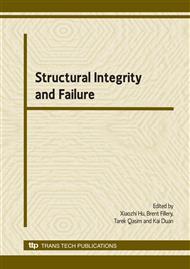p.157
p.169
p.175
p.183
p.189
p.199
p.207
p.215
p.221
An Evaluation of the Effective Block Approach for Predicting Crack Growth under an Untested Spectrum Using P-3C and F-111 Test Data
Abstract:
Recently an effective block approach has been proposed to address the experimentally observed high growth rates of fatigue cracks at the critical locations on F/A-18 airframes. This approach treats a spectrum block as one equivalent constant amplitude cycle. Hence, the crack growth rate may be represented by a Paris-type equation, with the model parameters dependent on the load spectrum. This approach has been applied to the F/A-18 crack growth analysis, with good correlation to experimental data. In this paper, we summarise recent evaluation work of the approach using experimental data obtained under P-3C and F-111 spectra. An improved method for transferring the model parameters from a tested spectrum to an untested spectrum, suggested by the first author of the current paper, has been evaluated in comparison to the original procedure proposed. The soundness of relying on third-party tools based on constant amplitude model for the prediction of relative severity of spectra is also discussed. Finally, the advantages and limitations of the effective block approach are highlighted.
Info:
Periodical:
Pages:
189-197
Citation:
Online since:
April 2008
Authors:
Price:
Сopyright:
© 2008 Trans Tech Publications Ltd. All Rights Reserved
Share:
Citation:


